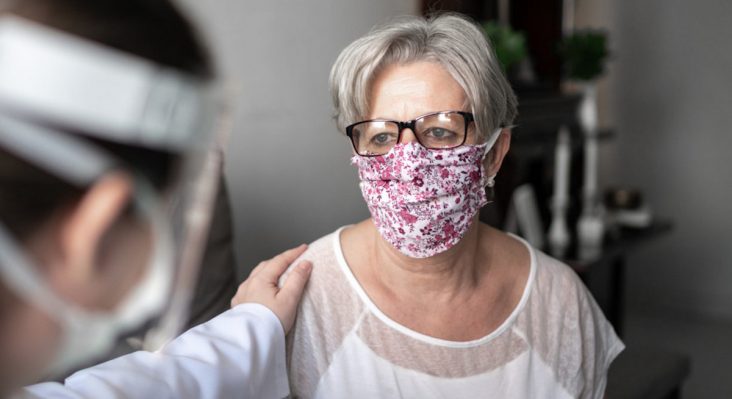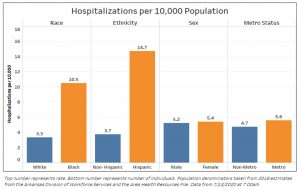UAMS modeling shows decline in estimated COVID-19 cases, disproportionate minority rates
by July 22, 2020 12:14 pm 1,466 views

Updated COVID-19 modeling from the University of Arkansas for Medical Sciences (UAMS) shows fewer cases and deaths than expected a few weeks ago, but warns that the state could soon lose the “ability to effectively contact trace” without timelier test results.
Top line estimates from the updated model predict 40,000 known cumulative COVID cases by July 28, and 437 deaths by Aug. 1. As of July 21, there were 34,655 known cases and 374 deaths.
The updated modeling reported July 21 uses Arkansas Department of Health (ADH) data available between July 13-15. UAMS has said they plan to update the model every two weeks.
Not only do the number of deaths, new cases and hospitalizations decline in the new “eSIR” model, but the peak for the categories is pushed from late October to mid and late November. The eSIR model predicts total infections, including asymptomatic infections, the number of active cases, the demand for hospital beds, ICU beds, and ventilators at the peak of the epidemic in Arkansas. (Link here for a PDF of the updated modeling.)
Following are the updated estimates.
• Mean-case estimates
Nov. 26
Cumulative cases: 103,651
Hospitalizations: 2,591
ICU beds: 777
Ventilators: 543
• Worst-case estimates
Nov. 14
Cumulative cases: 168,570
Hospitalizations: 4,214
ICU beds: 1,264
Ventilators: 884
Following are the estimates from the July 7 modeling,
• Mean-case estimates
Oct. 29
Cumulative cases: 111,776
Hospitalizations: 2,794
ICU beds: 838
Ventilators: 586
• Worst-case estimates
Oct. 24
Cumulative cases: 186,026
Hospitalizations: 4,650
ICU beds: 1,395
Ventilators: 976
“Figures for the worst case scenario are, of course, higher and are provided for comparison. The worst-case model is outside the 85% confidence zone and has a less than 5% chance of being the actual estimate for that time period,” UAMS noted in its updated modeling report.
The updated UAMS report also picks up on a concern about the lack of nationwide testing capacity expressed in recent weeks by Gov. Asa Hutchinson. The governor has said demand on commercial labs from rising cases in Arizona, California, Florida, Texas and other states has reduced the number of commercial lab test results in Arkansas. The lack of capacity will likely result in the state missing its goal of 200,000 tests results in July. The ADH said July 14 it is working to double its testing capacity by acquiring two “high thru-put instruments.”
“We are at a time period in Arkansas in which we will learn whether we can gain some type of control over the COVID-19 epidemic in the state,” UAMS noted. “It was clear from earlier and current projections Arkansas is on the verge of losing the ability to effectively contact trace because of high numbers of daily cases. To be effective, test results must be reported and cases notified and contacts traced within 24 to 48 hours.”
DEMOGRAPHIC DIFFERENCES
The updated modeling also included COVID-19 demographic factor comparisons based on case data as of July 13. The numbers show a higher rate of hospitalizations per 10,000 among Hispanics, but a higher rate of hospitalizations per COVID cases among Blacks.
“Associated with the high rates of COVID-19 among communities of color are higher rates of hospitalization. Blacks have three times as many hospitalizations as Whites. Hispanics have nearly four times time the rate of hospitalizations as Whites,” the report noted.
• Hospitalizations per 10,000 population
Hispanic: 14.7%
Black: 10.5%
White: 3.3%
Female: 5.4%
Male: 5.2%
Urban: 5.6%
Rural: 4.7%
• Hospitalizations per 1,000 COVID cases
Black: 112.9
White: 68.3
Hispanic: 48.5

